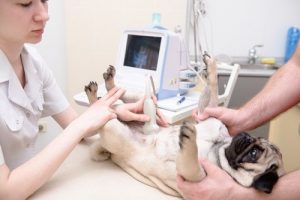5 Tips for Your Dog's Postpartum Care


Written and verified by the lawyer Francisco María García
Postpartum care of a first-time dog is essential. The first steps will be to monitor the dog’s hygiene after delivery. In addition to this, you must monitor the hygiene of the bed where it looks after its puppies.
During the postpartum period, the dog must be separated from other adult dogs. The reason for this is that they may infect it with diseases or parasites. It’s also very important to feed it puppy food, which has a high energy and protein content.
The mother’s nipples can get mastitis, and for this reason, it’s necessary to monitor them daily during the postpartum care period. In this way, the dog can recover in a stress-free environment.
First steps in a female dog’s postpartum care

During the postpartum phase, one of the most important things is to keep the birthing area clean. This is where the mother and her puppies, and it to be kept clean. It’s a good idea to give the dog a good bath with warm water, and this will cleanse and relax her.
These hygiene steps will help to reduce the risk of infections from bacteria, both in the case of the mother and the puppies.
If this area isn’t kept clean, then the mother may ingest pieces of placenta and other organic remains associated with the birth. Lack of hygiene can be a dangerous source of infections.
Mastitis
If we notice canine mastitis in time, then it can be treated with warm compresses. You should also consult your vet, so that the problem doesn’t get any worse. The puppies’ teeth appear at around one-month-old.
Therefore, to avoid injuries to the mother’s nipples, we have to monitor how the little ones breastfeed. You’ll probably have to teach them how to feed in a slightly less aggressive way.
Feeding
When puppies have their milk teeth, then it’s time for them to start eating some solid foods. This will be done little by little with specific products for each stage of their development.
One advantage here is that the puppy will get used to the food it will have when fully grown. And, secondly, it will start to depend less and less on breastfeeding, and in turn, give the mother some relief.
In order for a female dog to recover well, it must have quality food which is rich in calories and proteins. She must always have food in her bowl. In this way, she’ll be able to eat when she needs to, in between feeding the puppies.
Water is also a fundamental element. The hydration of the mother is very important, most of all for the production of milk with which to feed the litter.
The comfort of the mother
As with people, mother dogs and their puppies also need reassurance and comfort during the postpartum care period. The bed for the mother and her offspring should be in a quiet place, away from where most of the household normally walk.
On the other hand, if lots of people come to see the puppies during this postpartum period, it will make the mother very nervous. It’s best to leave the animal on its own, and respect the privacy of the entire litter.
Cesarean delivery
When the birth has required a cesarean section, the mother will require specific care in order for the wounds to heal properly.

You should clean the wound with a good disinfectant diluted in water, and keep it as dry as possible. It’s important to stop the dog licking or touching the area. There are products on the market that can help us with this.
After a cesarean section, it’s not advisable for the dog to suckle the litter because of the risk of damage to the wound. In addition, there is a possibility that the female may reject the puppies after the cesarean section. If that happens, it will be necessary to feed the young by bottle.
Keep in mind that this rejection can be due to other reasons too. Sometimes it may not be possible to deduce why it has happened. In these cases, the owners will have to take charge of the rearing of the puppies by bottle, and with the help of other specific products too. In this way, the pups will be able to develop correctly.
All cited sources were thoroughly reviewed by our team to ensure their quality, reliability, currency, and validity. The bibliography of this article was considered reliable and of academic or scientific accuracy.
- Al-Bassam, M. a, Thomson, R. G., & O’Donnell, L. (1981). Normal postpartum involution of the uterus in the dog. Canadian Journal of Comparative Medicine. Revue Canadienne de Médecine Comparée.
- Panciera, D. L., Troy, G. C., & Purswell, B. J. (2014). Blastomycosis in a postpartum dog. Medical Mycology Case Reports. https://doi.org/10.1016/j.mmcr.2014.09.002
-
Murai, A., Maruyama, S., Nagata, M., & Yuki, M. (2013). Mastitis caused by Mycobacterium kansasii infection in a dog. Veterinary Clinical Pathology. https://doi.org/10.1111/vcp.12056
This text is provided for informational purposes only and does not replace consultation with a professional. If in doubt, consult your specialist.